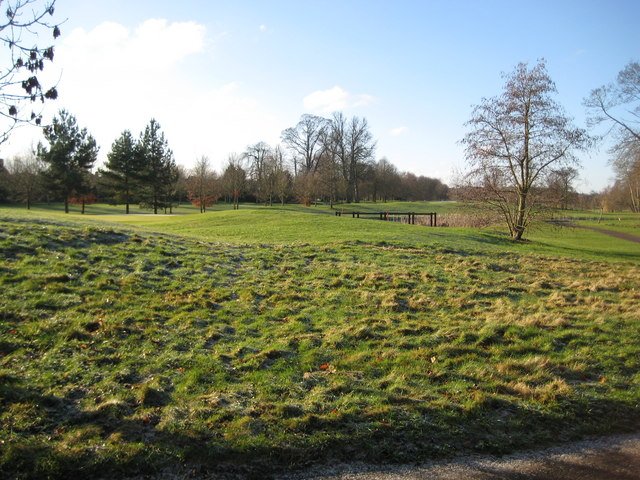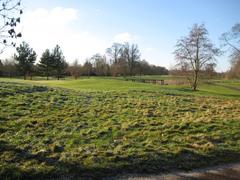
Second Battle of Newbury Battlefield Visitor Guide: Hours, Tickets & Planning Your Visit
Date: 14/06/2025
Introduction
The Second Battle of Newbury, fought on 27 October 1644, remains a pivotal moment in the English Civil War, highlighting the intense struggle between Royalist and Parliamentarian forces. Set amid the scenic landscapes of Berkshire, the battlefield and its associated sites—including Donnington Castle and Shaw House—offer immersive experiences for history enthusiasts and casual visitors alike. This comprehensive guide covers everything you need to plan your visit, from historical context and key attractions to practical information on hours, tickets, and accessibility.
Table of Contents
- Historical Overview
- Key Sites and Features
- Practical Visitor Information
- Events, Preservation, and Responsible Visiting
- FAQs
- Visual Resources
- Summary and Recommendations
- References
Historical Overview
Political and Military Context
The Second Battle of Newbury took place during a critical phase of the English Civil War (1642–1651), a conflict between King Charles I’s Royalists and Parliamentarian forces seeking expanded parliamentary power. By late 1644, the Parliamentarians had gained momentum after victories such as Marston Moor, but the war’s outcome remained uncertain. King Charles I aimed to relieve the besieged Donnington Castle, gathering Royalist forces in Berkshire, while Parliamentarian commanders sought to trap and defeat the king (History Hit).
Strategic Importance of Newbury
Newbury’s location on the main route between London and the west made it a vital strategic point for both armies. The area had already seen one major clash in 1643, underlining its ongoing military significance (History Hit).
Forces and Commanders
King Charles I personally led a Royalist force of around 10,000, including Prince Rupert of the Rhine and Lord Astley. The Parliamentarian army, nearly 19,000 strong, was commanded by the Earl of Essex, Sir William Waller, and the Earl of Manchester. Lack of coordination among Parliamentarian leaders would prove costly (English Civil War Society).
Prelude, Battle, and Aftermath
After relieving Donnington Castle, Charles I entrenched his forces between Shaw House and Speen, leveraging rivers and hedgerows for defense. On 27 October 1644, Parliamentarian forces attacked from two directions. While Waller’s flanking maneuver at Speen made gains, Manchester’s assault on Shaw House stalled. As night fell, the Royalists withdrew, avoiding defeat.
The battle was tactically indecisive, but Parliamentarian disunity highlighted the need for military reform. This led to the creation of the New Model Army, which would change the course of the war (History Hit).
Key Sites and Features
Donnington Castle
A 14th-century fortress, Donnington Castle was a Royalist stronghold during the battle and subsequent sieges. Today, its ruined gatehouse and earthworks are managed by English Heritage, offering panoramic views and interpretive signage (English Heritage: Donnington Castle).
Shaw House
This Elizabethan mansion served as Royalist headquarters and now features exhibitions, guided tours, and period architecture. The house is a hub for Civil War interpretation and community events (West Berkshire Heritage Forum).
Speen Village, Clay Hill, and Battlefield Trails
- Speen Village: Site of fierce fighting and Royalist defenses.
- Clay Hill: Key Parliamentarian position, partially preserved with walking access (HistoryLearning.com).
- Battlefield Walks: Marked routes traverse open fields and hedgerows, revealing remnants of earthworks and historic boundaries.
Practical Visitor Information
Hours and Ticketing
Donnington Castle
- Opening Hours: Grounds open daily from dawn to dusk.
- Tickets: Free entry to the grounds; no ticket required (English Heritage).
Shaw House
- Opening Hours: Tuesday to Sunday, 10:00 AM – 5:00 PM.
- Tickets: £8 adults, £5 children (5–16), free for under-5s. Family and group rates available. Purchase online or at the entrance.
Battlefield Trails
- Access: Free via public footpaths year-round.
Guided Tours and Walking Routes
- Self-Guided Walks: Follow waymarked trails connecting Donnington Castle, Shaw House, and Speen. Maps and information panels are provided on-site and online.
- Guided Tours: Seasonal guided walks led by local historians or the Battlefields Trust. Book via Newbury Corn Exchange or Battlefields Trust Events.
Getting There and Parking
- By Car: Newbury is accessible via M4 (J13) and A34. Free parking at Donnington Castle (Castle Lane, RG14 2LE); additional parking in Newbury town center.
- By Train: Newbury Station (London Paddington line) is a short taxi or bus ride from key sites.
- By Bus: Local routes serve Donnington, Shaw, and Speen.
Facilities and Accessibility
- Toilets: Facilities at Shaw House and in Newbury town center.
- Food & Drink: Cafés and pubs in Newbury, Speen, and near Donnington Castle (e.g., Bowlers Arms).
- Accessibility: Donnington Castle and Shaw House offer wheelchair access; some battlefield trails may be uneven. Accessible parking and rest areas are available.
Events, Preservation, and Responsible Visiting
- Anniversary Events: Commemorative walks and reenactments take place in October (Battlefields Trust Events).
- Heritage Preservation: English Heritage and local groups maintain the site’s historic character. Visitors are asked to stay on marked paths and respect private land.
- Leave No Trace: Carry out litter and avoid disturbing earthworks or wildlife.
Frequently Asked Questions (FAQ)
Q: What are the visiting hours for Donnington Castle?
A: Open daily from dawn to dusk; grounds are free to access.
Q: Is Shaw House open year-round?
A: Typically Tuesday to Sunday, 10:00 AM–5:00 PM; check for seasonal variations.
Q: Are guided tours available?
A: Yes, both Shaw House and local organizations offer guided tours, especially during anniversaries.
Q: Are the sites accessible for visitors with disabilities?
A: Shaw House and Donnington Castle have accessible facilities; some trails may be uneven.
Q: Is there parking?
A: Free parking at Donnington Castle and Shaw House; additional options in Newbury.
Q: Do I need to buy tickets in advance?
A: Not required for Donnington Castle. Recommended for Shaw House and guided tours during peak times.
Q: Can I bring my dog?
A: Dogs are allowed on public footpaths; restrictions may apply near buildings and farmland.
Visual Resources
-
Donnington Castle Gatehouse Image
Alt text: Donnington Castle Gatehouse – Second Battle of Newbury Historical Site -
Battlefield Map
Alt text: Map of Second Battle of Newbury Battlefield
For more visuals, interactive maps, and virtual tours, visit the Battlefields Trust website.
Summary and Recommendations
Visiting the Second Battle of Newbury battlefield offers a unique opportunity to explore a crucial chapter of English history amidst picturesque countryside. Donnington Castle’s ruins, Shaw House’s exhibitions, and accessible battlefield trails make for an enriching, educational experience for all ages. Plan your visit by confirming opening hours, booking tours in advance during busy periods, and making use of available maps and audio guides.
For a deeper experience, download the Audiala app for guided audio tours, and follow local heritage organizations for updates on events and preservation efforts.
References
- Battlefields Trust: Second Battle of Newbury
- Battlefields Trust: Second Battle of Newbury
- English Heritage: Donnington Castle
- History Hit: Best Historic Sites in Berkshire
- English Civil War Society: Second Battle of Newbury
- HistoryLearning.com: Second Battle of Newbury
- West Berkshire Heritage Forum: Second Battle of Newbury
- WarHistory.org: The Second Battle of Newbury
- Clash of Steel: Second Battle of Newbury
- Newbury Town Walks Guide
- Corn Exchange Events
- Penny Post Events
- Visit Newbury: History
- The Cultural Experience: English Civil War Battlefield Tour
- The Collector: Historical Places in Berkshire
- Windsor Visitor Information
For a more immersive experience, download the Audiala app to access guided audio tours and interactive maps, and follow us on social media for updates and historical news.

